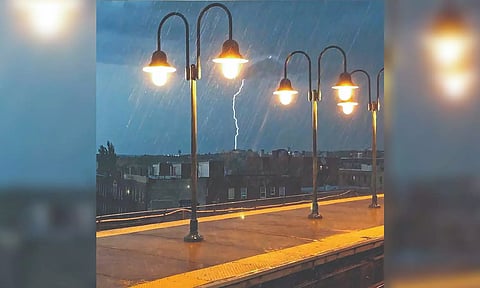

By Nicholas Bakalar
NEW YORK: Lightning comes and goes in brilliant and terrifying flashes. With powerful enough satellites in orbit, all that crackling static in the world’s skies is being brought into view. The latest visualization of atmospheric electricity comes from Meteosat Third Generation, a European satellite launched in December. Its cameras can track and record lightning strikes, even the smallest and fastest ones, day and night, over more than 80 percent of Earth’s surface. It was the first of six such satellites that will eventually track weather around the world.
The European Space Agency released the first batch of imagery from the Meteosat orbiter last week, revealing flickers of lightning over regions of Western Europe, Africa and South America. The agency shared the imagery as it calibrated the satellite with its partners ahead of making it fully operational by the end of this year.
The satellite’s Lightning Imager has four cameras, each with five lenses. The cameras can capture a single flash of lightning that lasts as little as 0.6 milliseconds, much faster than the blink of an eye, and it can take clear pictures at 1,000 images per second.
The National Oceanographic and Atmospheric Administration in the United States has been tracking lightning in North and South America since 2017, using the Geostationary Lightning Mapper aboard the Geostationary Operational Environmental Satellites, known as GOES. The European system expands lightning detection to regions of Europe, Africa and the Middle East (with overlapping coverage in parts of South America), and provides significant technological improvements that will yield a bounty of data for the world’s weather forecasters.
“First, we have better resolution,” said Guia Pastorini, a project engineering manager at Leonardo S.p.A., the aerospace company that developed the imager on Meteosat. “We are able to detect even a single lightning bolt, while GOES can detect only a group of events. And in terms of energy, we can detect weaker lightning strikes.”
The data from the imager will be useful in weather prediction, said Carlo Simoncelli, a program manager at Leonardo. Lightning is associated with tornadoes, and there is a large increase in lightning that remains within clouds about a half-hour before a tornado. Being able to spot that from space, Mr. Simoncelli said, “gives us the capacity for an early warning about events that can be catastrophic.”
That the system is always on and producing data in all conditions is a big advantage. “It’s quite simple to identify lightning at night in the desert,” Ms. Pastorini said. “But if you look at lightning reflecting over the ocean or just during the daytime, it’s much more difficult.”
Steve Goodman, a recently retired senior scientist at the National Oceanographic and Atmospheric Administration who spent the last 10 years working on the Geostationary Lightning Mapper of the GOES satellites, noted that the European systems were based on decades-old ideas. At some far northern latitudes, he said, the cameras’ resolution will be no better than the American satellites. But he also said overall greater resolution of the European imager helped to detect smaller and weaker lightning.